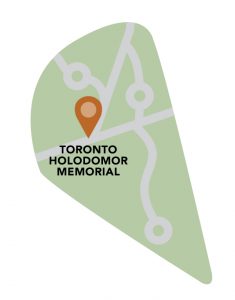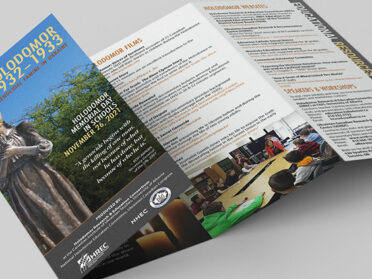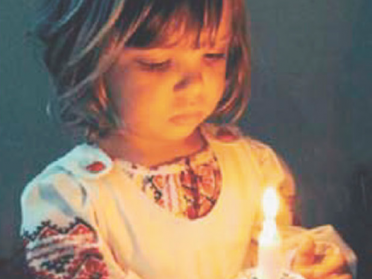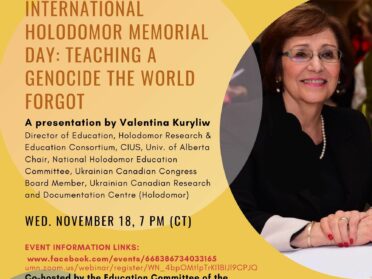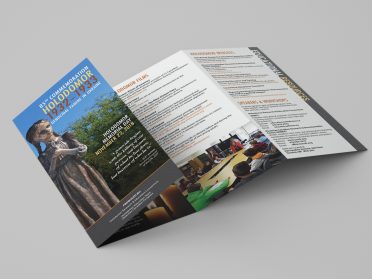Holodomor Memorial Day 2021
A downloadable educational pamphlet with teaching resources to use for Holodomor Memorial Day
Holodomor Memorial Day is commemorated each year on the fourth Friday of November in schools as a Day of Remembrance when we remember the millions of Ukrainians who were starved to death in Ukraine in 1932 and 1933, many of whom were children.
Through Acts of Parliament, the Government of Canada recognizes The Holodomor as an act of genocide. Together with the descendants of survivors living in Canada, let us remember the victims of the Holodomor.
 Loading...
Loading...
Holodomor Memorial Day – November 26, 2021
A genocide begins with the killing of one person, not because of what he has done, but because of who he is.
Holodomor Memorial Day in Schools: the 4th Friday of November
On the 29 May of 2008, the Parliament of Canada unanimously passed an “Act to Establish a Ukrainian Famine and Genocide (Holodomor) Memorial Day and to Recognize the Ukrainian Famine 1932-1933 as an Act of Genocide.” As a result of the advocacy of the Holodomor Education Team (UCC-Toronto) and later the National Holodomor Education Committee (NHEC), in 2008, the Toronto District School Board passed a resolution to hold an annual Holodomor Memorial Day in schools on the fourth Friday of November. Since then, other school boards across the country have followed suit. Each year for this event, the National Holodomor Education Committee (NHEC) and increasingly HREC Education, prepare an information pamphlet to help educators commemorate this day in their schools.
Worldwide, Holodomor Memorial Day Is November 27 (4th Saturday Of November)
Basic Facts About The Holodomor
- Stalin issued a series of policies targeting the population of Ukraine which led to genocide by starvation in Ukraine.
- The Holodomor occurred in a time of peace, not as a result of war or natural disaster.
- Food was used as a weapon.
- Wheat and other grains were confiscated from farmers by the Communist government. Some of it was sold for export to fund Stalin’s Five-Year Plan.
- 1/3 of all villages in Ukraine were blacklisted, blockaded and the people were left to starve to death.
- Millions of innocent people died.
- 28,000 people died per day at the height of the Holodomor in June of 1933.
- 31% of those who died were children under the age of 10.
- Additionally, the cultural, religious and political leadership of Ukraine was largely destroyed during the 1930s.
- The Holodomor was denied, covered up and ignored by the world for over five decades.
- The Government of Canada officially recognized the Holodomor as genocide in May 2008.
* according to the latest research
Produced by the Holodomor Research and Education Consortium at CIUS–University of Alberta, and the National Holodomor Education Committee of the Ukrainian Canadian Congress.
The Toronto District School Board has prepared two teaching units on the Holodomor for the World History and World Politics Grade 12 courses (2009). It is available to school boards upon request.
Memorial Day Announcement
By Melania Schturyn, student & granddaughter of a Holodomor survivor
Today is a day of remembrance for the millions of victims of the Ukrainian genocide, the Holodomor, in which the population of Ukraine was starved to death in 1932-1933. Ukraine was, at the time, an agricultural nation with some of the richest soil in the world in which 85% of its citizens were farmers. It was known as “the breadbasket of Europe” for its bountiful production of grain. This man-made famine resulted from policies implemented by Joseph Stalin, the leader of the Communist Party of the USSR and his regime. Through Stalin’s Five Year Plan of industrialization and collectivization, unrealistic grain quotas were imposed on Ukraine’s farming communities which led to much of the grain in Ukraine being conÿscated to sell abroad, leaving the population to starve. In addition, communist activists travelled to every house searching every nook and cranny for hidden food. Using metal rods, they would prod the earth looking for hidden storage places. If they found any of the forbidden food, it was conÿscated, the owner of the house was punished by execution or sent to the gulag, the rest of the family was often evicted from their home without their belongings. This resulted in mass starvation.
By June of 1933 the greatest number of deaths by starvation occurred. 28,000 people died each day, 31% of them were children under the age of 10.
My grandfather, Stephen Horlatsch, who was himself a child at the time, spoke to me about the horrors he experienced every day: people dropping like ̃ies all around him as he walked to school, communist activists beating women and children for not cooperating in handing over their last bits of food, and executions everywhere he looked. His own mother, my great-grandmother, was brutally beaten before his eyes – a memory which haunted him all his days. In the spring, he was sent out to gather edible plants or bark on trees for food so that his mother could throw together some concoction to eat to keep their family alive. This was true for many families. For the people lucky enough to survive the Holodomor, a lasting trauma remained with them the rest of their lives.
That is why every fourth Friday and Saturday in November we take the time to remember the millions of souls that were brutally taken from us by forced starvation.
Educational Resources
Holodomor: Voices of Survivors
A 30 minute DVD with firsthand accounts of 25 Canadian survivors who tell their stories as children during the Holodomor.
Contact: office@ucrdc.org
The Soviet Story
The first 11 minutes are an excellent introduction to the Holodomor.
www.sovietstory.com
Hunger For Truth: The Rhea Clyman Story
The Canadian journalist and eyewitness of the Holodomor in Ukraine was amongst the first to write about it.
www.holodomortour.ca
Genocide Revealed
This award-winning documentary features personal and historical archival information on the Holodomor. Educational versions are available on DVD in 26 & 52 minute segments.
Contact: yurij@yluhovy.com
Harvest of Despair
This award-winning documentary provides background information with media coverage from the 1930s.
Ukrainian Canadian Research and Documentation Centre 416-966-1819, office@ucrdc.org, www.ucrdc.org/Films.html
Stalin’s Secret Genocide
Provides reflections from Holodomor researchers on various aspects of the story in a 15 minute overview.
www.holodomortour.ca
Bitter Harvest
A feature film presenting life in Ukraine before and during the Holodomor through the life of two young adults.
www.bitterharvestfilm.com
http://georgemendeluk.com/projects/
Mr. Jones
Holodomor Research & Education Consortium (HREC)
Teaching materials, lesson plans and other resources and educational materials. HREC Education is an Accepted Educational Partner of the Toronto District School Board (TDSB)
education.holodomor.ca
Ukrainian Canadian Research & Documentation Centre (UCRDC)
Share the Story: Short excerpts of 80 Canadian survivors of the Holodomor.
www.sharethestory.ca
www.holodomorsurvivors.ca
Edmonton Catholic School District
Lesson plans and suggested activities for all grades.
https://www.ecsd.net/page/1585/holodomor-memorial-day
Manitoba Education and Training
Lesson plans and suggested activities for all grades.
www.edu.gov.mb.ca/k12/cur/multic/holodomor.html
Connecticut Holodomor Committee
“Exposing the Ukrainian Holodomor–How starvation was used as a political weapon”
Unit 2, Chapter 5
www.voicesintoaction.ca/Learn/Unit2/Chapter5/
“How A Grain of Wheat Linked Two Worlds” Unit of study
https://www.stf.sk.ca/unit-plan/how-grain-wheat-linked-two-worlds
To visit, view exhibits and hear survivor testimonies, book speakers and workshops, contact:
Holodomor Research & Education Consortium (HREC)
Conducts teacher training sessions, workshops, class visits and presentations, with educational materials.
Website: education.holodomor.ca
Phone: 416 923 4732
Email: hreced@ualberta.ca
Ukrainian Canadian Research & Documentation Centre (UDRDC)
Conducts class visits and presentations featuring testimonies of survivors and their children, shows documentary ÿlms and exhibits photos and posters.
Website: www.ucrdc.org
Phone: 416 966 1819
Email: office@ucrdc.org
Both are located at: 620 Spadina Avenue, 2nd Floor Toronto, ON M5S 2H4
The Photograph
by Kat Karpenko, NJ: BookBaby, 2020
Kat was inspired to write the book after discovering her grandfather’s farewell gathering before they left Ukraine in 1928. It consists of their extended family in Ukraine, and she weaves stories of each of them based on her research, including accounts from the mouths of survivors. An excellent and gripping read for students in the West who may wonder what befell the families that were left behind and experienced the Holodomor.
Philipovna: Daughter of Sorrow
by Valentina Gal, Toronto: Guernica Editions Inc. (Miroland), 2019
Valentina wrote the book based on her mother’s diary and describes how in the early 1930s tactics of deliberate starvation and denial of basic rights were used to force the people of Ukraine to surrender to the Stalin regime. The story is told through the eyes of a young, orphaned girl who witnessed the brutal results of that regime. It illustrates the fragility of human rights and how they can be obliterated by corruption and power, yet it is a very accessible and an exciting read for both students and adults.
Holodomor In Ukraine,
The Genocidal Famine: 1932-1933
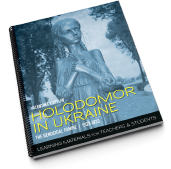
by V. Kuryliw, Edmonton: CIUS Press, 2018
Teaching materials, lesson plans and assignments with straightforward, sensible and basic information about the Famine. The book is accessible, instantly useable and packed with ideas and photocopiable resources.
Contact: hreced@ualberta.ca
Red Famine: Stalin’s War On Ukraine
by A. Applebaum, NY: Doubleday Books, 2017 An authoritative book on the Ukrainian genocide based on the most recent research.
The Holodomor Reader
by B. Klid & A. Motyl, Edmonton: CIUS Press, 2012 A collection of key texts and materials.
https://www.ciuspress.com/product/the-holodomor-reader/?v=3e8d115eb4b3
Stalin’s Genocides
by N. Naimark, Princeton, NJ: Princeton University Press, 2010
Features the Holodomor and other genocides of the Soviet period.
Bloodlands: Europe Between Hitler and Stalin
by T. Snyder, New York: Basic Books, 2010
One major chapter specifically on the Holodomor.
Holodomor of 1932-1933 in Ukraine: Documents and Materials
by R. Pyrih, Kyiv: Kyiv-Mohyla Academy Publishing House, 2008
73 archival documents with correspondence about the Holodomor.
Print copies: hreced@ualberta.ca
E-version: education.holodomor.ca/educational- resources-list/pyrih-documents/
HREC Educator Award For Holodomor Lesson Plan Development
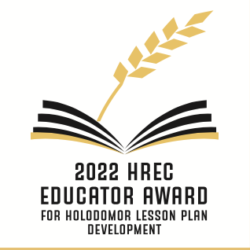 The annual HREC Educator Award for Holodomor Lesson Plan Development is intended to foster the development of innovative, creative and interactive lessons for grades K-12 that develop critical thinking skills while addressing the topic of the Holodomor, and to recognize the outstanding educators who create them. The winning lesson plans will be posted on the HREC Education website.
The annual HREC Educator Award for Holodomor Lesson Plan Development is intended to foster the development of innovative, creative and interactive lessons for grades K-12 that develop critical thinking skills while addressing the topic of the Holodomor, and to recognize the outstanding educators who create them. The winning lesson plans will be posted on the HREC Education website.
This year’s applications must be submitted by May 1, 2022.
Toronto Holodomor Memorial
![]()
Holodomor Memorial Parkette, Exhibition Place
The Bitter Memories of Childhood monument by Ukrainian sculptor Petro Drozdovsky was unveiled in October 2018 for the 85th Commemoration of the Holodomor in Ukraine. The statue depicts the most vulnerable of the Holodomor’s victims and provides an opportunity for student re ̨ection.
Located just inside the Princes’ Gate entrance of the Canadian National Exhibition (CNE) grounds, the memorial site includes a pathway through a small park leading to 3 millstones, each of which provides QR code information about the Holodomor, and the statue. Students can re ̨ect on the history, survivor testimonials and legacy of the Holodomor.
For more information on this and other monuments, visit: education.holodomor.ca/introduction/holodomor-monuments/
April 16 Holodomor Remembrance Day In Schools
The Ukrainian Canadian Congress designated April 16 as Holodomor Remembrance Day in Schools, together with HREC and UCC’s National Holodomor Education Committee (NHEC). The Holodomor is one of nine global genocides recognized by the Government of Canada and by six of Canada’s provincial legislatures. It was in the Spring of 1933, during the Holodomor’s deadliest year, that the number of deaths escalated significantly.
Every year in April, Ukrainians worldwide traditionally visit cemeteries and remember the dead with special memorial ceremonies held the week after Easter, when victims of the Holodomor are specifically remembered.
April is Genocide Remembrance, Condemnation, Prevention & Education Month
On April 24, 2015, the House of Commons unanimously passed a historic motion (M-587) to recognize the month of April as Genocide Remembrance, Condemnation and Prevention Month.
Canada has been a°ected by many genocides and recognizes: the Armenian Genocide, Ukrainian Holodomor, Jewish Holocaust, the Genocide Against the Tutsi in Rwanda and the Genocide in Bosnia. The Canadian Parliament has also recognized the ongoing genocide being committed against the Yezidi in Syria and Iraq today, the Rohingya in Myanmar, the Romani during WWII,
and currently the Uyghurs in China.
Educators are encouraged to take time in April to remember those who su°ered and lost their lives in the Holodomor and other genocides, and to commit to using education to protect and defend human rights and dignity everywhere.
All Memorial Day Posts
Holodomor Memorial Day Holodomor Memorial Day in Schools: the 4th Friday of November On the 29 May of 2008, the Parliament of Canada unanimously passed an “Act to Establish a Ukrainian Famine and Genocide (Holodomor) Memorial Day and to Recognize the U...
Continue Reading Holodomor Memorial Day 2024Holodomor Memorial Day Holodomor Memorial Day in Schools: the 4th Friday of November On the 29 May of 2008, the Parliament of Canada unanimously passed an “Act to Establish a Ukrainian Famine and Genocide (Holodomor) Memorial Day and to Recognize the U...
Continue Reading Holodomor Memorial Day 2023Holodomor Memorial Day Holodomor Memorial Day in Schools: the 4th Friday of November On the 29 May of 2008, the Parliament of Canada unanimously passed an “Act to Establish a Ukrainian Famine and Genocide (Holodomor) Memorial Day and to Recognize the U...
Continue Reading Holodomor Memorial Day 2022Holodomor Memorial Day – November 26, 2021 Holodomor Memorial Day in Schools: the 4th Friday of November On the 29 May of 2008, the Parliament of Canada unanimously passed an “Act to Establish a Ukrainian Famine and Genocide (Holodomor) Memorial ...
Continue Reading Holodomor Memorial Day 2021Nov 1–Nov 31 Holodomor: A Remembrance. A Virtual Visual Art Presentation, Featuring Works by Lydia Bodnar-Balahutrak of Houston, TX. Developed by the virtual exhibition team Roksolana Karmazyn, Chrystia Bryndzia, Ksenia Rychtycka, Anizia Karmazyn, and O...
Continue Reading Upcoming November 2020 Holodomor Memorial EventsMINNEAPOLIS, MN – on November 18, 2020, the Center for Holocaust and Genocide Studies (CHGS) at the University of Minnesota and the Ukrainian American Community Center (UACC) of Minneapolis invited author, educator and advocate of Holodomor teaching and...
Continue Reading In commemoration of International Holodomor Memorial Day: Teaching a Genocide the World ForgotHolodomor Memorial Day – November 27, 2020 Holodomor Memorial Day in Schools: the 4th Friday of November On the 29 May of 2008, the Parliament of Canada unanimously passed an “Act to Establish a Ukrainian Famine and Genocide (Holodomor) Memorial ...
Continue Reading Holodomor Memorial Day 2020Holodomor Memorial Day – November 22, 2019 Holodomor Memorial Day is November 22, 2019. For schools (4th Friday of November). Worldwide, Holodomor Memorial Day is November 23 (4th Saturday of November). Basic Facts About The Holodomor * accordi...
Continue Reading Holodomor Memorial Day 2019Holodomor Memorial Day – November 23, 2018 Holodomor Memorial Day is November 23, 2018. For schools (4th Friday of November). Worldwide, Holodomor Memorial Day is November 24 (4th Saturday of November). Basic Facts * according to the latest res...
Continue Reading In commemoration of the 85th anniversary of the Ukrainian Holodomor of 1932–1933, the Genocidal Famine in Ukraine2017 is the 84th year of the commemoration of the Holodomor – the Ukrainian genocide of 1932-33 – when over 4 million Ukrainians were starved to death. It was brought about by the policies of Joseph Stalin, the leader of the former Soviet Union. Every...
Continue Reading Holodomor Memorial Day 2017

